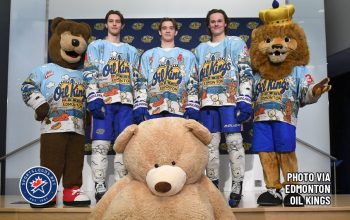It’s been 17 years since the Hartford Whalers last played hockey, but their logo lives on in ways that no one could have predicted when it was unveiled in 1979. You would expect fans of the team to carry the torch for their beloved Whalers, who left Connecticut to become the Carolina Hurricanes in 1997—and indeed fan clubs for the team exist. But the Hartford Whalers have become a phenomenon that extends beyond New England and even beyond sports.
The logo’s designer, Peter Good, is among those who are surprised by the whale tail’s longevity. “It seems that it’s gone from professional hockey to kind of an interesting social icon that has an appeal for some reason,” he said.
 When a video of a Red Sox fan nonchalantly catching a foul ball at Fenway Park went viral earlier this season, there was the Whalers logo on his shirt. It has been spotted on actress Megan Fox, Yankees general manager Brian Cashman, NBA player Nate Robinson, and on Adam Sandler in the movie Grown Ups, to name a few of the places it’s popped up on the pop culture landscape.
When a video of a Red Sox fan nonchalantly catching a foul ball at Fenway Park went viral earlier this season, there was the Whalers logo on his shirt. It has been spotted on actress Megan Fox, Yankees general manager Brian Cashman, NBA player Nate Robinson, and on Adam Sandler in the movie Grown Ups, to name a few of the places it’s popped up on the pop culture landscape.
Even in the team’s new home, the Whalers are not forgotten. “I was asked for an interview on a North Carolina radio station,” Good said, “because they were saying that all the Carolina Hurricane fans were coming in with Whalers apparel on.”
These days, rebranding efforts take months or even years to complete, with market research and focus groups and consumer panels and whatnot. But when the New England Whalers of the World Hockey Association joined the NHL in 1979, the creation of their new logo was not exactly a lengthy process.
“This was done very, very quickly,” Good said. “They needed something in a week or two or something like that.”
 When Good started to design the new logo for the NHL’s Whalers, the only precedent he had to work with was the logo for the WHA’s New England Whalers, who played from 1972 to 1979. The New England Whalers logo featured an actual harpoon, the likes of which actual people use to kill actual whales. While sensibilities may have been different then, this still caused some conceptual problems. For obvious reasons, Good wanted to take a completely different approach.
When Good started to design the new logo for the NHL’s Whalers, the only precedent he had to work with was the logo for the WHA’s New England Whalers, who played from 1972 to 1979. The New England Whalers logo featured an actual harpoon, the likes of which actual people use to kill actual whales. While sensibilities may have been different then, this still caused some conceptual problems. For obvious reasons, Good wanted to take a completely different approach.
“There’s a conflict with using harpoons and your mascot is a whale,” Good said. “Harpoons are symbolic of killing whales, so you’re really expressing the idea of killing your own mascot. So I said, let me see if I can do something more positive.”

That “something more positive” would become one of the most successful logos in sports history. Early sketches of the logo, which can be found on the website of Good’s design firm, Cummings & Good, show the origins of the logo. Good explains:
I did a version, it had the negative H in the W, but instead of the whale’s tail, it had harpoons working with it. And [team owner] Howard Baldwin actually chose it. He said ‘I like that one.’ I said ‘Why do you like that one?’ He said, ‘Because it has the H for Hartford,’ and I said, ‘Wait a minute. That was not a requirement. That was just one that I tried. Now that I know that, give me some more time.’
 The logo features a simple W and a blue whale tail, which together, of course, form the letter H in the negative space (also known as white space, figure/ground relationship, or my favorite, counterform). From a design standpoint, there was a certain amount of luck in the fact that all three elements that make up the logo, the W, the tail, and the H, are symmetrical.
The logo features a simple W and a blue whale tail, which together, of course, form the letter H in the negative space (also known as white space, figure/ground relationship, or my favorite, counterform). From a design standpoint, there was a certain amount of luck in the fact that all three elements that make up the logo, the W, the tail, and the H, are symmetrical.
The negative-space H feels obvious now—like the arrow in the FedEx logo, once you’ve seen it, you can’t unsee it—but that wasn’t always the case. “Years after I did the logo, I would get this call: ‘I saw the H!’” Good said. “Because a lot of people didn’t see the negative H.”
That a logo can be at once simple and clever is part of its appeal. It doesn’t try too hard. “It’s so unusual in its purity and pure design,” Good said. “There’s no angry whale, no aggressive whale showing its teeth or whatever like so many sports icons.”
Even the colors are more soothing than they are intimidating. And because of that, of course, “It’s a logo that I don’t think would ever happen again today,” Good said.
 On the ice, the Whalers were not a very good team. In 1991, they traded franchise player Ron Francis along with Ulf Samuelsson to the Pittsburgh Penguins, who then went on to win consecutive Stanley Cup championships, which was something of a punch in the gut to fans. And to make matters worse, in 1992, the Whalers tweaked their beautiful logo, for the dumbest reason possible.
On the ice, the Whalers were not a very good team. In 1991, they traded franchise player Ron Francis along with Ulf Samuelsson to the Pittsburgh Penguins, who then went on to win consecutive Stanley Cup championships, which was something of a punch in the gut to fans. And to make matters worse, in 1992, the Whalers tweaked their beautiful logo, for the dumbest reason possible.
“I remember their office calling me and saying, ‘Is there any way of making the logo more aggressive?’” Good said. “And I said, ‘You know, no. I really can’t see that. And that’s not going to help you win games. Try winning some games, and that will solve the problem.’ And so I refused to do that.”
The team changed the logo anyway, making it darker and pointier and trapping it in a weird outline against a grey background, but that 1992 version is not what hockey fans in New England remember. “When I look at all the retro stuff, there’s very few that use that altered state,” Good said. “They went back to the original, which is much better proportioned.”
Speaking of all that retro stuff being sold out there, there is no simple answer to the question of who owns the Whalers logo. The NHL sells Whalers merchandise, but so does Cummings & Good. The agreement that would have given the NHL control of the logo was never finalized.
It was never work for hire. I never signed an agreement. In fact, I have an agreement that they asked me to sign in the ’80s, signing the rights over to them for the logo, and a check for a dollar to validate it. I still have the unsigned letter and I still have the uncashed check. —Peter Good
The fact that this is even an issue so many years after the team’s relocation is amazing. You don’t hear nearly as much about other major sports teams that relocated in the 1990s or early 2000s, like the NFL’s Houston Oilers, the NHL’s Quebec Nordiques, or the NBA’s Vancouver Grizzlies. Only the Montreal Expos, who relocated to Washington, DC, after the 2004 season, rival the Whalers for defunct team popularity.
There’s very little chance that the Whalers will ever play hockey in Hartford again, but so long as Megan Fox, Adam Sandler, and every diehard hockey fan in Connecticut carries the team in their heart and on their T-shirt, the team and its logo will live on.













